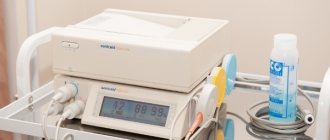Meconium aspiration syndrome
(CAM) is a condition that is caused by a mixture of amniotic fluid and meconium entering the lungs, accompanied by difficulty breathing. The symptoms may be concerning but are usually temporary.
SAM is a rare condition that usually affects a small number of preterm and post-term infants. Some children will require breathing support, including an oxygen mask and a ventilator.
SAM can sometimes cause complications such as pneumonia. However, most children recover and have no long-term complications.
In this article, we will look at the symptoms, causes, and possible complications of SAM.
Content
- 1 Causes 1.1 Passage of meconium as a result of fetal distress
- 1.2 Meconium passage as a result of fetal maturation
- 2.1 Airway obstruction
- 4.1 Prevention during pregnancy
- 5.1 Assisted ventilation techniques
Causes
The main theories for the passage of meconium into the amniotic fluid are caused by fetal maturity or fetal stress as a result of hypoxia or infection. Other factors contributing to the passage of meconium in the womb
maternal conditions include placental insufficiency, maternal hypertension, preeclampsia, and maternal tobacco and cocaine use. However, the exact mechanism by which meconium passes into amniotic fluid is not fully understood, and it may be a combination of several factors.
Passage of meconium as a result of fetal distress
There may be an important association between fetal distress and hypoxia with MSAF. Fetal distress is thought to develop into fetal hypoxia, causing the fetus to defecate meconium, leading to MSAF and then possibly MAS. Other stressors that cause fetal distress and therefore meconium passage include when umbilical vein oxygen saturation is below 30%.
Fetal hypoxic stress during labor may stimulate colonic activity by increasing intestinal motility and relaxing the anal sphincter, leading to the passage of meconium. Then, due to intrauterine inspiration or the first few breaths after delivery, MAS may develop. Additionally, aspiration of thick meconium leads to airway obstruction, leading to more severe hypoxia.
It is important to note that the association between fetal distress and meconium passage is not a definite cause-and-effect relationship, as more than a quarter of infants with MSAF are active at birth and are not distressed or hypoxic. In addition, fetal distress often occurs without passage of meconium.
Passage of meconium as a result of fetal maturity
Although meconium is present in the gastrointestinal tract early in development, MSAF rarely occurs before 34 weeks of gestation.
Fetal intestinal motility is present as early as 8 weeks of gestation, and the anal sphincter develops around 20–22 weeks. The early mechanisms of anal sphincter control are not well understood, but there is evidence that the fetus defecates regularly into the amniotic cavity even in the absence of distress. The presence of fetal intestinal enzymes has been detected in the amniotic fluid of women at 14–22 weeks' gestation. Thus, it is assumed that intestinal contents pass freely into the amniotic fluid.
Motilin is found in higher concentrations in the gastrointestinal tract of the fetus after birth compared to preterm. Similarly, intestinal parasympathetic innervation and myelination also increase in later pregnancy. Therefore, the increased incidence of MAS in postterm pregnancies may reflect the maturation and development of gastrointestinal motility in the newborn.
What is meconium aspiration syndrome?
SAM occurs when a mixture of amniotic fluid and meconium enters the lungs.
Meconium
is a dark green sticky substance that the fetus swallows while in the womb. Meconium is passed from the newborn as the first stool. Amniotic fluid surrounds the fetus in the uterus.
If a newborn gets amniotic fluid and meconium into the lungs, these substances can block the airways. This results in symptoms such as difficulty breathing and a bluish tint to the skin.
This condition usually occurs in premature newborns born between 37 and 39 weeks of gestation who are still small for their gestational age, or newborns born after 42 weeks of gestation.
CAM also increases the likelihood of developing severe infections such as pneumonia, which can be especially severe in premature babies because their immune systems have not yet matured.
SAM is a rare condition. Study published in the scientific journal International Journal of Pediatrics
, showed that about 0.18% of full-term newborns have this condition.
Pathophysiology
Because MAS describes a spectrum of illness in neonates born through MSAF without any congenital respiratory disorder or other underlying pathology, there are many proposed mechanisms and causes of this syndrome. These disorders can have long-term consequences, for example, infants who develop MAS have a higher incidence of neurodevelopmental defects due to poor breathing.
Airway obstruction
In the first 15 minutes of meconium aspiration, there is obstruction of the larger airways, which causes increased pulmonary resistance, decreased pulmonary compliance, acute hypoxemia, hypercapnia, atelectasis, and respiratory acidosis. After 60 minutes of exposure, meconium enters the smaller respiratory tract. Once in the terminal bronchioles and alveoli, meconium causes inflammation, pulmonary edema, vasoconstriction, bronchospasm, airway collapse, and surfactant inactivation.
Fetal hypoxia
Areas of the lungs that do not or only partially participate in ventilation due to obstruction and/or destruction will become hypoxic, which can lead to an inflammatory response. Partial obstruction will cause air to become trapped and hyperinflate certain areas of the lungs, which can lead to pneumothorax. Chronic hypoxia leads to increased tone of pulmonary vascular smooth muscles and persistent pulmonary hypertension, causing respiratory and circulatory impairment.
Infection
Microorganisms, most often gram-negative rods, and endotoxins were found in MSAF samples more often than in clear amniotic fluid, for example, 46.9% of patients with MSAF also had endotoxins present. Microbial invasion of the amniotic cavity (MIAC) is more common in patients with MSAF, which can ultimately lead to an intra-amniotic inflammatory response. MIAC is associated with high concentrations of cytokines (such as IL-6), chemokines (such as IL-8 and monocyte chemoattractant protein-1), complement, phospholipase A2, and matrix-degrading enzymes. Therefore, these aforementioned mediators in the amniotic fluid during MIAC and intra-amniotic infection may, if aspirated in
utero,
cause pneumonia in the fetus.
Pulmonary inflammation
Meconium has a complex chemical composition, so it is difficult to identify one agent responsible for several emerging diseases. Because meconium is stored within the intestine and is partially unexposed to the immune system, when it is aspirated, the innate immune system recognizes the substance as foreign and dangerous. The immune system, which is present at birth, responds within minutes with low specificity and no memory to try to destroy germs. Meconium possibly leads to chemical pneumonitis because it is a potent activator of inflammatory mediators, which include cytokines, complement, prostaglandins, and reactive oxygen species.
Meconium is a source of proinflammatory cytokines, including tumor necrosis factor (TNF) and interleukins (IL-1, IL-6, IL-8), as well as mediators produced by neutrophils, macrophages and epithelial cells, which can directly affect lung tissue. or indirectly. For example, proteolytic enzymes are released from neutrophil granules, and they can damage the lung membrane and surfactant proteins. In addition, activated leukocytes and cytokines generate reactive nitrogen and oxygen species, which have a cytotoxic effect. Oxidative stress leads to vasoconstriction, bronchospasm, platelet aggregation and accelerated cell apoptosis. Recently, it has been hypothesized that meconium is a potent activator of toll-like receptors (TLRs) and complement, key mediators of inflammation, and thus may contribute to the inflammatory response in MAS.
Meconium contains large amounts of phospholipase A 2 (PLA 2), a potent pro-inflammatory enzyme that can directly (or through stimulation of arachidonic acid) lead to surfactant dysfunction, destruction of the lung epithelium, tissue necrosis and increased apoptosis. Meconium can also activate the coagulation cascade, production of platelet activating factor (PAF) and other vasoactive substances, which can lead to destruction of capillary endothelium and basement membranes. Damage to the alveolar capillary membrane results in leakage of fluid, plasma proteins, and cells into the interstitium and alveolar spaces.
Surfactant inactivation
The surfactant is synthesized by type II alveolar cells and consists of a complex of phospholipids, proteins and saccharides. It acts to reduce surface tension (to expand the lungs during inspiration), stabilize the alveoli at end expiration (to prevent alveolar collapse), and prevent pulmonary edema. The surfactant also helps protect and protect the lungs as it is also an anti-inflammatory agent. The surfactant helps remove inhaled particles and senescent cells from the alveolar structure.
The degree of surfactant inhibition depends on both the surfactant concentration and the meconium concentration. If the surfactant concentration is low, even very dilute meconium can inhibit surfactant function, whereas at high surfactant concentrations the effect of meconium is limited. Meconium can influence surfactant mechanisms by preventing surfactant from spreading across the alveolar surface, decreasing the concentration of surfactant proteins (SP-A and SP-B), and changing the viscosity and structure of surfactant. Following exposure to meconium, several morphological changes occur, the most notable of which is the detachment of the airway epithelium from the stroma and the release of epithelial cells into the airways. This indicates a direct detrimental effect on the alveolar cells of the lungs due to meconium entering the lungs.
Persistent pulmonary hypertension
Persistent pulmonary hypertension (PPHN) is the failure of the fetal circulation to adapt to ectopic conditions after birth. PPHN is associated with various respiratory diseases, including MAS (as 15-20% of infants with MAS develop PPHN), as well as pneumonia and sepsis. The combination of hypoxia, pulmonary vasoconstriction, and ventilation/perfusion mismatch can cause PPHN depending on the concentration of meconium in the airway. PPHN in newborns is the leading cause of death in MAS.
Apoptosis
Apoptosis is an important mechanism for clearing damaged cells and repairing tissue, but too much apoptosis can cause harm, such as acute lung injury. Meconium causes apoptosis and DNA cleavage of airway epithelial cells of the lungs, which is detected by the presence of fragmented DNA in the airways and in the nuclei of the alveolar epithelium. Meconium causes an inflammatory response in the lungs because the number of autophagocytic cells and caspase 3 levels increase after exposure. After 8 hours of meconium exposure in rabbit fetuses, the total number of apoptotic cells is 54%. Therefore, most meconium-induced lung injury may be caused by apoptosis of the lung epithelium.
Diagnostics
The release of meconium into the amniotic cavity and subsequent intrauterine breathing in full-term newborns can cause meconium aspiration syndrome.
Respiratory distress in a baby born with dark MSAF and meconium obstructing the airway is usually sufficient to diagnose MAS. Additionally, newborns with MAS may have other types of respiratory distress such as tachypnea and hypercapnia. MAS can sometimes be difficult to diagnose because it can be confused with other diseases that also cause respiratory distress, such as pneumonia. Additionally, X-rays and lung ultrasound can be fast, simple, and low-cost imaging modalities for diagnosing lung diseases such as MAS.
brief information
1.1 Definition
Neonatal respiratory distress syndrome or “respiratory distress syndrome” (RDS) is a respiratory disorder in children in the first days of life caused by primary surfactant deficiency and lung immaturity.
The incidence of RDS is higher at lower gestational age and body weight.
1.2 Etiology and pathogenesis
The main causes of RDS:
- violation of the synthesis and excretion of surfactant due to the functional and structural immaturity of the lung tissue;
- defect in the structure of the surfactant (extremely rare).
1.3 Epidemiology
1.4 ICD code - 10
P22.0 - Respiratory distress syndrome in a newborn.
1.5 Classification
No.
1.6 Clinical picture
- Shortness of breath in the first minutes/hours of life;
- Expiratory noises (“moaning breathing”);
- Recession of the chest during inhalation with tension of the wings of the nose, swelling of the cheeks ("trumpeter" breathing);
- Cyanosis;
- Decreased breathing, crepitating wheezing.
- Increasing need for additional oxygenation.
Prevention
Overall, the incidence of MAS has decreased significantly over the past two decades as the number of postpartum births has been minimized. Currently, labor is induced in women whose gestational age exceeds 41 weeks.
Prevention during pregnancy
Prevention during pregnancy may include amnioinfusion and antibiotics, but the effectiveness of these treatments is questionable.
Prevention during childbirth
As previously mentioned, oropharyngeal and nasopharyngeal suctioning is not an ideal preventative treatment for either energetic or depressed (not breathing) children.
Is it possible to prevent the development of the syndrome?
Strict adherence to medical recommendations and proper care of yourself and the fetus during pregnancy can often prevent problems leading to the appearance of meconium during childbirth. Smoking during pregnancy increases the risk of developing the syndrome. Other risk factors include:
- Pregnancy lasting more than 40 weeks.
- Diabetes or high blood pressure in the mother.
- Long and difficult labor.
- Insufficient oxygen supply to the fetus in the womb.
- Slow intrauterine development.
treatment
Most infants born as a result of MSAF do not require any treatment (other than routine postpartum care) as they show no signs of respiratory distress, as only approximately 5% of infants born as a result of MSAF develop MAS. However, infants who do develop MAS should be admitted to a neonatal unit where they will be closely monitored and given any necessary treatment. Surveillances include monitoring heart rate, respiratory rate, oxygen saturation, and blood glucose levels (to detect worsening respiratory acidosis or development of hypoglycemia). In general, treatment for MAS is more supportive.
Assisted ventilation techniques
Tracheal suction can be used to clear the airways of meconium, but this method is questionable and may be harmful.
In the case of MAS, there is a requirement for supplemental oxygen for at least 12 hours to maintain hemoglobin oxygen saturation at 92% or more. The severity of respiratory distress can vary significantly among newborns with MAS, as some require little or no supplemental oxygen and may require mechanical ventilation in severe cases. Desired oxygen saturation is 90 to 95%, and PaO 2 can reach 90 mm Hg. In cases where there is thick meconium deep in the lungs, mechanical ventilation may be required. In extreme cases, extracorporeal membrane oxygenation (ECMO) may be used in infants who do not respond to ventilator therapy. While on ECMO, the body can have time to absorb meconium and resolve all associated disorders. This treatment has been an excellent response as the survival rate of MAS with ECMO is over 94%.
Ventilating infants with MAS can be challenging, and because MAS can affect each individual differently, an individualized ventilation procedure may be required. Some newborns with MAS may have uniform changes in the lungs, while others may have inconsistent and heterogeneous changes in the lungs. Typically, sedatives and muscle relaxants are used to optimize ventilation and minimize the risk of pneumothorax associated with dyssynchronous breathing.
Inhaled Nitric Oxide
Inhaled nitric oxide (iNO) acts on vascular smooth muscle to cause selective pulmonary vasodilation. It is an ideal option for the treatment of PPHN because it causes vasodilation in the ventilated areas of the lungs, reducing ventilation-perfusion mismatch and thereby improving oxygenation. Treatment with iNO reduces the need for ECMO and reduces mortality in neonates with hypoxic respiratory failure and PPHN due to MAS. However, approximately 30-50% of infants with PPHN do not respond to iNO therapy.
Anti-inflammatory
Since inflammation is such a major problem in MAS, treatment consisted of anti-inflammatory medications.
Glucocorticoids
Glucocorticoids (GCs) have strong anti-inflammatory activity and reduce the migration and activation of neutrophils, eosinophils, mononuclear cells and other cells. GCs reduce the migration of neutrophils into the lungs ergo, reducing their adherence to the endothelium. Thus, the effect of mediators released from these cells is reduced and, consequently, the inflammatory response is reduced.
SHs also possess a genomic mechanism of action in which, once bound to the glucocorticoid receptor, the activated complex translocates to the nucleus and inhibits transcription of the mRNA. Ultimately influences whether different proteins are produced or not. Suppression of nuclear factor (NF-κB) and activator protein (AP-1) transcription attenuates the expression of pro-inflammatory cytokines (IL-1, IL-6, IL-8 and TNF, etc.), enzymes (PLA 2, COX-2 , iNOs, etc.) And other biologically active substances. The anti-inflammatory effect of GC is also manifested in increased activity of lipocortins, which inhibit the activity of PLA 2 and, therefore, reduce the production of arachidonic acid and mediators of the lipoxygenase and cyclooxygenase pathways.
Anti-inflammatory drugs should be administered as quickly as possible, since the effect of these drugs may wear off even one hour after meconium aspiration. For example, early administration of dexamethasone significantly increased gas exchange, decreased respiratory pressure, decreased the number of neutrophils in the bronchoalveolar region, and decreased edema formation and oxidative damage to the lungs. However, GCs may increase the risk of infection, and this risk increases with increasing dose and duration of glucocorticoid treatment. Other problems may occur, such as worsening diabetes mellitus, osteoporosis, skin atrophy, and growth retardation in children.
Phosphodiesterase inhibitors
Phosphodiesterases (PDEs) break down cAMP and cGMP, and different PDE isoforms may be involved in the respiratory system of a newborn with MAS due to their proinflammatory and smooth muscle contractile activity. Therefore, non-selective and selective PDE inhibitors can potentially be used in the treatment of MAS. However, the use of PDE inhibitors may cause cardiovascular side effects. Non-selective PDE inhibitors, such as methylxanthines, increase the concentration of cAMP and cGMP in cells, leading to bronchodilation and vasodilation. In addition, methylxanthines reduce the concentration of calcium, acetylcholine and monoamines, which controls the release of various mediators of inflammation and bronchospasm, including prostaglandins. Selective PDE inhibitors target one subtype of phosphodiesterase, and in MAS the activity of PDE-3, PDE-4, PDE-5 and PDE-7 may be enhanced. For example, milrinone (a selective PDE3 inhibitor) improved oxygenation and survival in newborns with MAS.
Cyclooxygenase inhibitors
Arachidonic acid is metabolized via cyclooxygenase (COX) and lipoxygenase to various substances, including prostaglandins and leukotrienes, which have potent pro-inflammatory and vasoactive effects. By inhibiting COX, and more specifically COX-2 (using selective or non-selective drugs), inflammation and swelling can be reduced. However, COX inhibitors can cause peptic ulcers and cause hyperkalemia and hypernatremia. Additionally, COX inhibitors have not shown significant response in the treatment of MAC.
Antibiotics
Meconium is usually sterile, but may contain various cultures of bacteria and may require appropriate antibiotics.
Treatment with surfactants
Lung lavage with dilute surfactant is a new treatment with potentially beneficial results depending on how early it is administered to newborns with MAS. This treatment is promising as it has a significant impact on air leaks, pneumothorax, need for ECMO, and death. Early intervention and its use in infants with mild MAS are more effective. There are risks, however, as instilling large volumes of fluid into a newborn's lungs can be dangerous (especially in cases of severe MAS with pulmonary hypertension) as it can worsen hypoxia and lead to death.
Previous procedures
MAS was initially thought to result from physical blockage of the airway by meconium. Thus, prenatal oropharyngeal and nasopharyngeal suction followed by tracheal aspiration have been used for 20 years to prevent the development of MAS in infants born with MSAF. This treatment was considered effective as it was reported to significantly reduce the incidence of MAS compared to neonates born through MSAF who did not receive treatment. This claim was later refuted, and future studies concluded that predelivery oropharyngeal and nasopharyngeal suctioning in infants born as a result of MSAF does not prevent MAS or its complications. In fact, it may cause more problems and damage (such as mucosal damage), so it is not a recommended preventive treatment. Suctioning may not significantly reduce the incidence of MAS because meconium passage and aspiration can occur in utero.
Thus, suctioning becomes unnecessary and useless since meconium may be deep in the lungs at the time of birth.
Historically, amnioinfusion was used when MSAF was present, which involves the transcervical infusion of fluid during labor. The idea was to dilute thick meconium to reduce its potential pathophysiology and reduce the incidence of MAS, since MAS is more common in cases of thick meconium. However, there are associated risks such as umbilical cord prolapse and prolongation of labor. UK National Institute for Health and Care Excellence (NICE) guidelines do not recommend the use of amnioinfusion in women with MSAF.
Treatment of meconium aspiration syndrome
Treatment for CAM will depend on the amount of meconium that enters the newborn's lungs, the duration of exposure, and the symptoms of the disease and overall health.
Doctors may use special devices to clear the upper respiratory tract, including the throat and mouth. Some newborns may also need to clear their lower airway, which doctors do by inserting a tube into the windpipe.
Some children may require supplemental oxygen through a face mask. Mechanical ventilation may also be necessary to maintain breathing.
If there are signs of a bacterial infection, your doctor may prescribe antibiotics. It is not always possible to prevent SAM. If the fetus is postterm, doctors may recommend inducing labor to reduce the risk of developing this condition.
Prevalence
1 out of every 7 pregnancies has MSAF, and of these cases, approximately 5% of these babies develop MAS. MSAF is observed in 23-52% of pregnancies at 42 weeks, so the incidence of MAS increases as gestational age advances, such that the prevalence is highest in postpartum pregnancies. Conversely, preterm births are not often associated with MSAF (only about 5% in total contain MSAF). The incidence of MAS decreases in populations in which labor is induced in women beyond 41 weeks' gestation. There are many putative pre-throwing factors that are thought to increase the risk of MAS. For example, the risk of MSAF is higher in African American, African, and Pacific Islander mothers compared to mothers from other ethnic groups.
Prevention and follow-up
If there is a threat of premature birth, transportation to obstetric hospitals of level II - III with a neonatal intensive care unit.
If there is a threat of premature birth at 32 weeks or earlier, transportation to a level III hospital (perinatal center).
If there is a threat of premature birth at 23-34 weeks, a course of corticosteroids is indicated for the prevention of RDS, IVH and NEC.
Schemes for intramuscular prenatal prevention of RDS:
- Betamethasone 12 mg 2 doses every 24 hours;
- Dexamethasone 6 mg 4 doses every 12 hours.
The maximum effect is achieved after 24 hours and lasts a week.
A repeat course in case of repeated threat of premature birth at less than 33 weeks is carried out after 2-3 weeks.
For a planned caesarean section due to lack of labor at 35-36 weeks, corticosteroid therapy is recommended.
If there is a threat of premature birth in the early stages, a short course of tocolytics:
- will allow transportation of the pregnant woman to the perinatal center,
- will complete the course of antenatal prevention of RDS with corticosteroids.
Antibacterial therapy is indicated for premature rupture of membranes.
Future Research
Research is focused on developing both a successful method for preventing MAS and an effective treatment. For example, research is being conducted on the effectiveness of anti-inflammatory drugs, surfactant replacement therapy, and antibiotic therapy. More research is needed into the pharmacological properties of, for example, glucocorticoids, including dosage, administration, timing, or any drug interactions. Additionally, research is still being conducted as to whether intubation and meconium suctioning in newborns with MAS is beneficial, harmful, or simply an unnecessary and outdated treatment. Overall, there is still no generally accepted therapeutic protocol and effective treatment plan for MAS.










